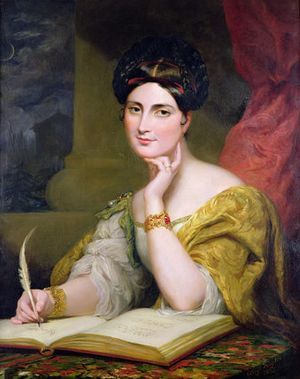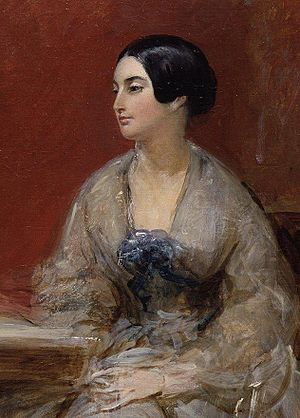Caroline Norton facts for kids
Quick facts for kids
Caroline Norton
|
|
|---|---|

Caroline Norton, by Sir George Hayter in 1832
|
|
| Born |
Caroline Elizabeth Sarah Sheridan
22 March 1808 |
| Died | 15 June 1877 (aged 69) London, England
|
| Nationality | British |
| Known for | Social reformer, writer |
| Title | Lady Stirling-Maxwell (1877) |
| Spouse(s) |
George Chapple Norton
(m. 1827; died 1875) |
| Parent(s) | Thomas Sheridan Caroline Henrietta Sheridan |
Caroline Elizabeth Sarah Norton, Lady Stirling-Maxwell (born March 22, 1808 – died June 15, 1877) was an important English social reformer and writer. She worked hard to change unfair laws. Her efforts helped pass three major laws: the Custody of Infants Act 1839, the Matrimonial Causes Act 1857, and the Married Women's Property Act 1870. She even posed for the famous painting Justice in the House of Lords. The artist, Daniel Maclise, chose her because many saw her as a victim of unfair laws.
Contents
Caroline Norton's Early Life and Marriage
Caroline Norton was born in London. Her father, Thomas Sheridan, was an actor and soldier. Her mother, Caroline Henrietta Callander, was a novelist. Caroline's grandfather was the famous playwright Richard Brinsley Sheridan.
In 1817, Caroline's father died in South Africa. This left her family with very little money. Luckily, Prince Frederick, Duke of York and Albany, a friend of her grandfather, helped them. He arranged for them to live in a special apartment at Hampton Court Palace for free. This was called a "grace and favour" apartment.
Caroline and her two sisters were known for their beauty and talents. People often called them the "Three Graces." Her older sister, Helen, became a songwriter. Her younger sister, Georgiana, was considered the prettiest.
In 1827, Caroline married George Chapple Norton. He was a lawyer and a Member of Parliament. Their marriage quickly became unhappy. George was often jealous and controlling. He also struggled with his career, leading to many arguments about money.
During her early marriage, Caroline became a popular hostess in London society. She was known for her charm and smart conversations. She made many friends, including famous writers and politicians. Some of her friends were Samuel Rogers, Edward Bulwer-Lytton, and even the future King Leopold I of Belgium.
George encouraged Caroline to use her connections to help his career. Because of her influence, he became a police magistrate in 1831. Caroline also started writing to express her feelings and earn money. Her first book, The Sorrows of Rosalie (1829), was well-liked. She also edited The Court Magazine and Belle Assemblée for several years.
Fighting for Justice: Caroline's Political Work
Caroline faced a sad event in 1842 when her youngest son, William, died. Her husband, George, had custody of their children after they separated. When William was very ill, George sent for Caroline. Sadly, William died before she could reach him. Caroline blamed George for their son's death, saying he had neglected him. After William's death, George allowed Caroline to visit their other sons, but he always supervised her visits.
Because of her own difficult experiences, Caroline became very passionate about changing laws. She especially wanted to help married and divorced women. She wrote poems like "A Voice from the Factories" (1836) and "The Child of the Islands" (1845) to share her political ideas.
In 1855, when Parliament was discussing divorce laws, Caroline shared her own marriage story. She explained how hard it was for women because of the unfair laws at the time.
Caroline campaigned very strongly for new laws. She even wrote a letter to Queen Victoria. Her efforts helped lead to three important laws:
- The Custody of Infants Act 1839: This law allowed mothers who were separated or divorced to gain custody of their children up to age seven. They could also visit their older children. However, it was still hard for women to use this law because they often needed a lot of money to go to court.
- The Matrimonial Causes Act 1857: This law made divorce easier and more affordable. It also changed how marriage was seen, making it more like a contract.
- The Married Women's Property Act 1870: This law was a huge step forward. It allowed married women to inherit property and take legal action on their own. For the first time, married women in the UK had a separate legal identity from their husbands.
In 1849, the artist Daniel Maclise finished his famous painting Justice in the House of Lords. He chose Caroline Norton to model for it. Many people saw her as a symbol of someone who had suffered from unfair laws.
Even though Caroline fought for women's legal rights, she did not support all parts of the women's movement. For example, she was not interested in women's suffrage, which was the right for women to vote. In 1838, she wrote in The Times newspaper that she believed women were naturally "inferior to man." She saw this as a part of her religious beliefs.
Caroline's Later Years
Caroline Norton had a friendship with a politician named Sidney Herbert in the 1840s. Later in life, she became friends with the writer George Meredith. She was the inspiration for the main character, Diana Warwick, in Meredith's novel Diana of the Crossways.
Caroline finally became free when her husband George died in 1875. In March 1877, she married an old friend, the Scottish writer and politician Sir W. Stirling Maxwell. Caroline Norton died in London just three months later.
Caroline's Family and Descendants
Caroline's oldest son, Fletcher Norton, sadly died from tuberculosis at age 30. This was a very difficult loss for her.
In 1854, her other son, Thomas Brinsley Norton, married an Italian woman named Maria Chiara Elisa Federigo. Thomas also had poor health and often relied on his mother for money. He lived long enough to become the 4th Baron Grantley. However, he also died before his mother in 1877.
His son, John, inherited the title and family estates. The 5th Lord Grantley was interested in coins and collected many of them. He also grew orchids.
Remembering Caroline Norton
In April 2021, English Heritage honored Caroline Norton with a blue plaque. This plaque marks her home in London where she lived for over 30 years. It was placed on 3 Chesterfield Street, Mayfair, to remember her important work.
Caroline Norton's Works
Political Writings
- A Voice from the Factories, 1836
- Separation of Mother and Child by the Laws of Custody of Infants Considered, 1837
- A Plain Letter to the Lord Chancellor on the Infant Custody Bill, 1839
- Letters to the Mob, 1848
- English Laws for Women in the Nineteenth Century, 1854
- A Letter to the Queen on Lord Chancellor Cranworth's Marriage & Divorce Bill, 1855
- A Review of the Divorce Bill of 1856, with propositions for an amendment of the laws affecting married persons, 1857
Poetry Books
- The Sorrows of Rosalie: A Tale with Other Poems, 1829
- I Do Not Love Thee, 1829
- The Cold Change, 1829
- The Undying One and Other Poems, 1830
- The Faithless Knight, 1830
- The Dream, and Other Poems, 1840
- The Child of the Islands, 1845
- Aunt Carry's Ballads for Children, 1847
- Bingen on the Rhine, undated
- The Centenary Festival, 1859
- The Lady of La Garaye, 1862
Novels
- The Dandies Rout, 1825
- The Wife, and Woman's Reward, 3 vols, 1835
- Stuart of Dunleath, 1851
- Lost and Saved, 3 vols, 1863
- Old Sir Douglas. 3 vols, 1866
Plays
- The Gypsy Father, 1830
- Vathek, 1830
See also
 In Spanish: Caroline Norton para niños
In Spanish: Caroline Norton para niños




